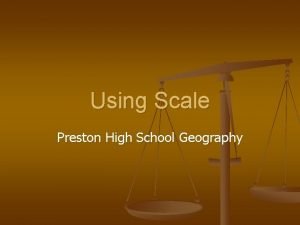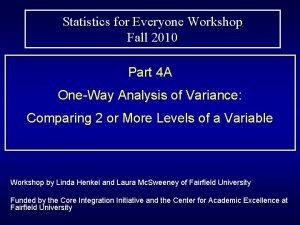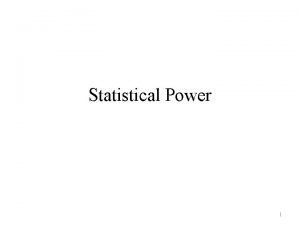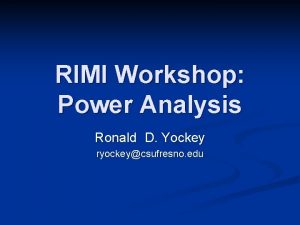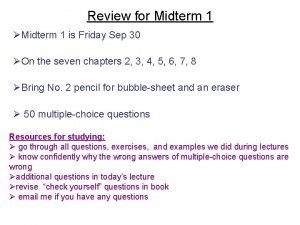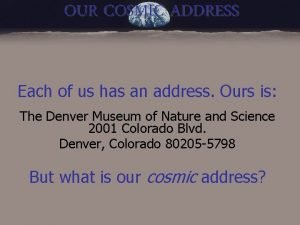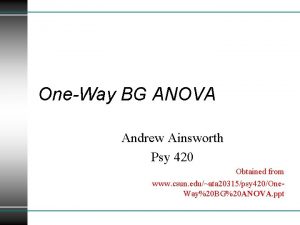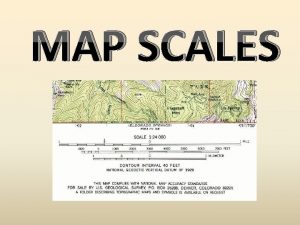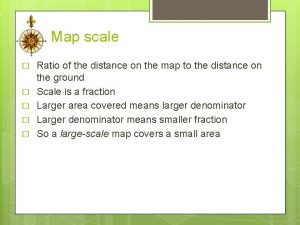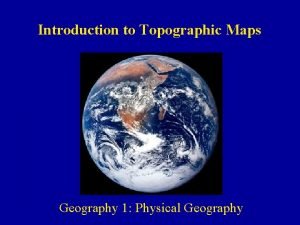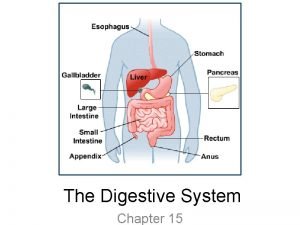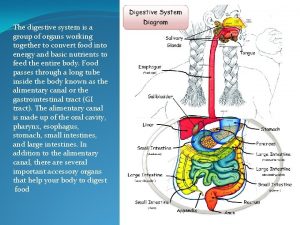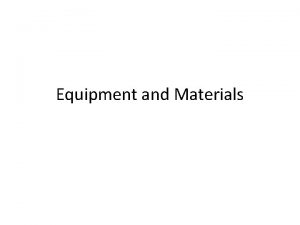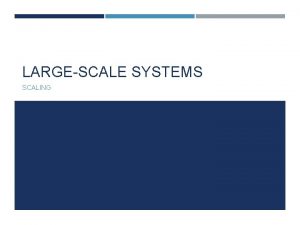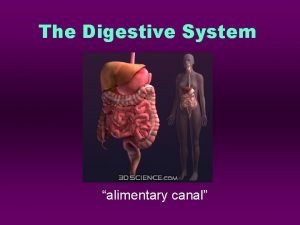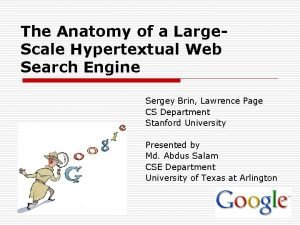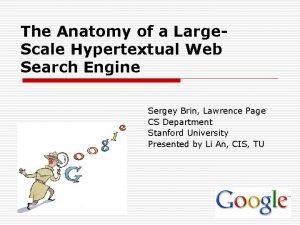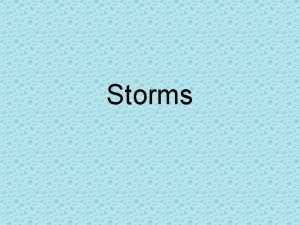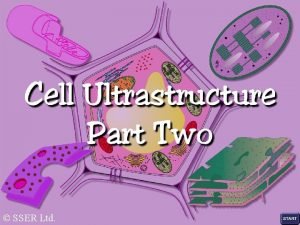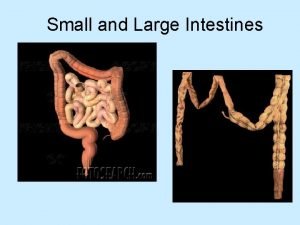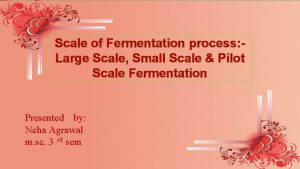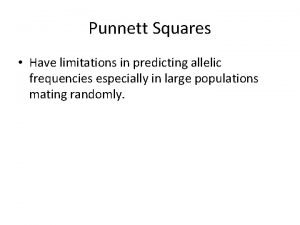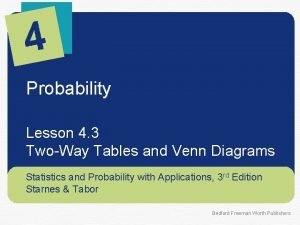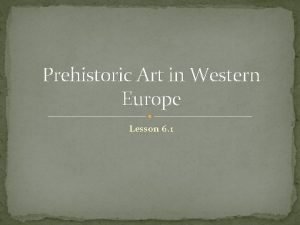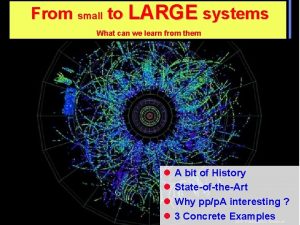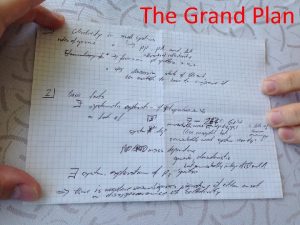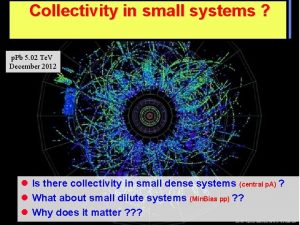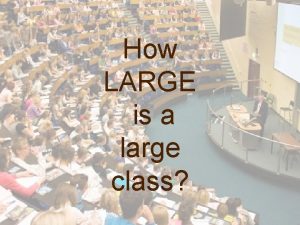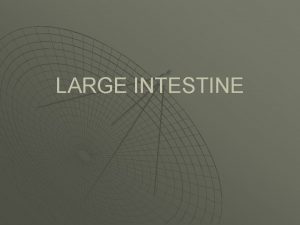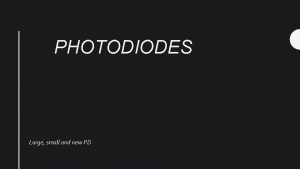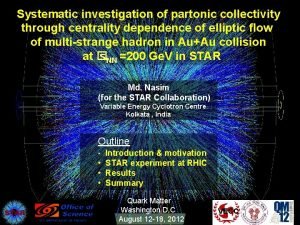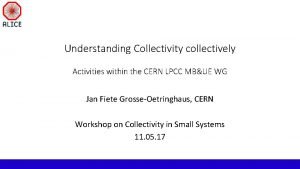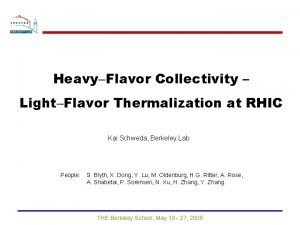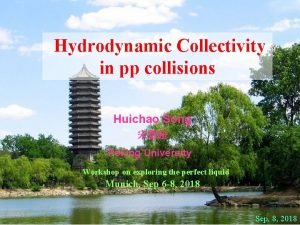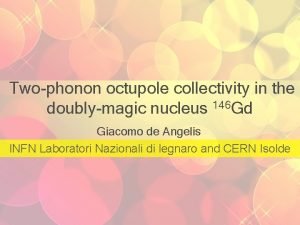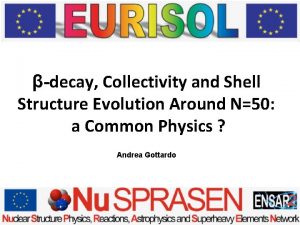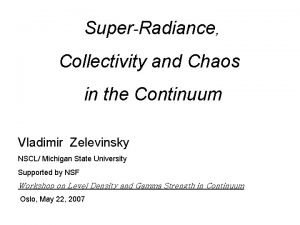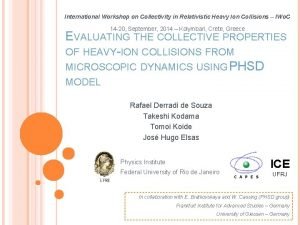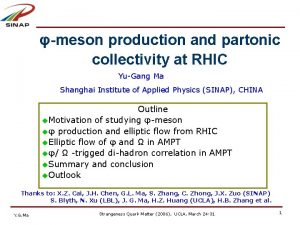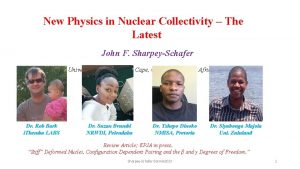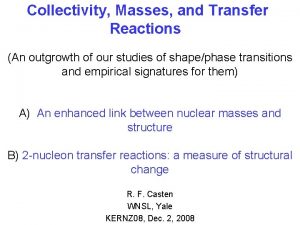Collectivity in small systems From small to LARGE







































- Slides: 39

Collectivity in small systems ! From small to LARGE systems (depends on what you mean by 'collectivity') What can we learn from them 1 l l A bit of History State-of-the-Art Why pp/p. A interesting ? 3 Concrete Examples 2017 Puebla WS J. Schukraft

Why are small systems interesting ? l The pre- LHC answer ð pp = “Baseline” µ SEP*: Soft QCD is too difficult, hard QCD too imprecise lets measure what happens in ‘elementary’ collisions p ð p. A = “Cold Nuclear Matter” modifications Note: COMOVERS are not CNM µ IS: shadowing, energy loss of incoming partons, ↑ with √s (small x) µ FS: interaction inside nuclei (p, n) ↓ with √s (Lorentz g) ð AA = “QGP” (hot/dense/macroscopic strongly interacting matter) µ modifications to baseline (pp) after correcting for CNM (p. A) RAA l The LHC “September Revolution” 2 * SEP = Somebody else's problem (21. 9. 2010) 2017 Puebla WS J. Schukraft

Surprise l The first LHC Discovery (pp 7 Te. V, Sept 2010) ð long range rapidity ‘Ridge' in 2 -particle correlations µ visible in the highest multiplicity pp collisions µ arguably still the most unexpected LHC discovery 'Near Side Ridge 'Away Side JET' ? 'Near Side JET' 3 Yale 2018 J. Schukraft

Origin of the pp 'Ridge' l Spawned a large number of different explanations ð mostly rather ad hoc, very speculative, or outright weird l IS: Color Glass Condensate CGC: 'first principles' theory ð 'new state of cold & dense parton matter' µ classsical FT in high density limit (small x, small Q 2) µ some success describing aspects of ep, pp, e. A: geometric scaling, low-x, particle production, . . l FS: Collective flow (Hydro) ? ð vaguely similar correlations in nucleus-nucleus Pb. Pb 10 -20% Flow pp 7 Te. V 4 Yale 2018 J. Schukraft

State-of-the-Art “QGP” signals 2018 measured ? l missing in this table ð low mass dileptons : seen Pb. Pb, not seen p. Pb, pp 5 ð CME, CMW: seen Pb. Pb , p. Pb, not measured pp) ð column with low multiplicity pp ! Not measurable with standard methods BUT: eg Y(2)/Y(1); h-jet correlation Yale 2018 J. Schukraft

Smooth Evolution down to d. N/dy ~ 0 ! HBT Nch & k. T dependence Charge Balance Function Pb. Pb space-time-momentum correlation! pp ALICE EPJC 76 (2016) 86 Pb. Pb pp p. Pb pp, p. Pb Alice 1606. 07424 ALICE PRC 93 (2016) 054908 Strangeness Enhancement CMS 1605. 06699 pp Pb. Pb p. Pb ‘Radial flow’ 6 2017 Puebla WS J. Schukraft

Azimuthal Flow in pp/p. A l Hydro-Dynamics: p. A almost as well measured as AA ð LO: radial (v 0) & directed (v 1) & elliptic (v 2) (< 2010) ð NLO: higher harmonics, cumulants, fluctuations ð NNLO: non-linear mode mixing, . . µ vn≠ en, mode coupling µ factorization violation v(p. T 1, p. T 2) ≠ v(p. T 1)*v(p. T 2 LO: PID v 2 NNLO: Factorization test NNLO: mode mixing NLO: cumulants 7 Yale 2018 J. Schukraft

Flow magnitude fairly independent of Nch? Geometry: eccentricity vs # sources sublead. /leading v 2 mode (aka factorization violation) v 2, v 3, v 4 vs Nch 1312. 6555 v 2 response coefficient v 2/e 1708. 07113 v 4 l largely by accident ! ð vn ~ k * e µ k ↓ ~ 1/(1+S/N) µ e ↑ ~1/√N Normalized Symmetric Coefficients (aka nonlinear mixed harmonics) 1106. 4345 1807. 02012 1303. 1794 8 Yale 2018 J. Schukraft

Why are small systems interesting ? l 'Looking under the hood': what makes the s. QGP tick ? ð stat. mechanics (thermo & hydro) hide very well the details: d. o. f & dynamics µ strength & limitation: same results for different underlying 'stuff' (theories/models) µ thermal system knows nothing about how and why it arrived in equilibrium ð go towards and beyond the limits of thermo & hydro µ study deviations due to finite size/finite time (=> small systems) l 'Looking for the onset': how does (strong) collectivity emerge f(r, t) ? ð change size & lifetime & density (pp -> p. A -> AA) l 'Looking for the beginning': universal aspects of soft QCQ ? ð looking for connection & smooth evolution from MB pp(e+e-) to central AA, with p. A the bridge in between 9 2017 Puebla WS J. Schukraft

What are we looking at ? The effect of the fluctuating proton size on the study of chiral magnetic effect in proton-nucleus collision https: //arxiv. org/abs/1712. 02486 Nch distribution Nrec/2. 3 ≈ d. Nch/dh l parton content of p@LHC (QM 2008) # of partons in proton 3 + ò g(x > 2 Ge. V) SPS RHIC LHC 4 30 10 high p. T tracks vs # Multi Parton Interactions l pp@LHC ≈ central SS@SPS, ≈ mid-central Cu. Cu@RHIC ð d. N/dh ≈ 50 - 100 ð NMPI ≈ 15 -20 (≈ Ncoll) 10 2017 Puebla WS J. Schukraft

What are we looking at ? Nrec/2. 3 ≈ d. Nch/dh l central AA: dense & large l central pp/p. A: dense & small ð e ≈ AA, S ≈ 1/10 @ same d. N/dh l peripheral AA: dilute & large ð e: pp≈p. A» AA S: pp≈p. A «AA @same d. N/dh l Min. Bias pp: dilute & small Proton Area S ? 60 mb/4 => A = 1. 5 fm 2 rrms = 0. 88 => A = 2. 4 fm 2 r. HBT(MB) ~ 1. 1 => A = 4 fm 2 11 pp Area ? 2017 Puebla WS J. Schukraft

Small systems are tricky ! l centrality ≠ geometry (b, Npart, e, . . ) ð Rp. A type measurements extremely difficult ð revealed strong RAA bias in peripheral (> 60%) µ no measurable jet quenching for very peripheral ! Nch vs Npart RAA vs p. T RAA (p. T > 8) vs centrality 95 -100% Phythia bias Nch/Npart vs centrality Pb. Pb ! 95 -100% 12 RAA ≈ 1 for > 75% no (measurable) jet quenching 2017 Puebla WS J. Schukraft

Small systems are tricky ! l dynamics bias depends on system and Nch <p. T> vs Nch nonflow ~ 1/N in general stronger in pp than in p. Pb flow ~ const. c 2{4} vs Nch v 2 in general bias is = √-c 2{4} stronger in pp than in p. Pb (@ same Nch) c 2{4} vs Nch p. Pb c 2{4} vs Nch=> better (& easier) to use p. Pb than pp pp

1) Onset: “Flow-like” Collectivity down to d. N/dy ≈ 0 ? => 7 Te. V pp Min Bias l Large&Dense (AA) <-> Small&Dense (centr. p. A) <-> Small&Dilute (MB pp) ð TH relevance: µ far outside applicability of statistical mechanics (thermo/hydro) µ special property of s. QGP (HIP) -> generic property of QCD (HEP) ð Experimental issue: µ tiny signal, large background (‘non-flow’) µ new analysis methods, new observables ? 14 Puebla WS J. Schukraft 2017

How far down in Nch ? 15 2017 Puebla WS J. Schukraft

How far down in Nch ? Assumption: v 2(bin-0) = 0 Assumption: v 2(bin-0) = v 2(bin-1) d. Nch/dh ≈ 3! MB MB 16 2017 Puebla WS J. Schukraft

How far down in Nch ? Questions (2016) & Preliminary Answers (2019) concerning the “Onset” ð How far down in d. N/dy can we find ‘collectivity’ in pp ? µ conceivably d. Nch/dh ≤ 3 (< ½ MB) ð What about e+e- (no IS geometry, no MPI) µ QM 18: no positive signal (upper limits) ð What is the scaling variable (d. N/dy, 1/S d. N/dy, e, . . ) ? µ ? ? ? ð New observables/analysis methods to reduce ‘non-flow’ µ Dh gaps, 3(4)subevent method, . . µ “ 1 st-bin” problem unsolved (what would be the “baseline” ? ) 17 pp Min. Bias 2017 Puebla WS J. Schukraft

2) Under the Hood: HD-Hydro vs LD-Transport The questions are NOT: - Can hydro be described by transport ? Yes, transport theory often IS the microscopic physic of hydro** - Will transport smoothly evolve from free streaming to hydro? Yes, with in(de)creasing Knudson number (R/lmfp)-1 = ? Two sides of the same coin (different approximations but similar results) Or Different physics & different observable consequences 7 Te. V pp Min Bias # collisions/particle >> 1 K= l/R << 1 ð Pressure Tomography: driven via pressure gradients in momentum space l High Density Paradigm: Hydro: l Low Density Paradigm: Transport # collisions/particle < 1 ð Density Tomography: driven by density gradients in coordinate space The questions IS: Are HD hydro and LD transport observationally distinct ? i. e. qualitative or significant quantitative differences ** Ad. S/CFT is an alternative in any/all of the relevant systems (pp, p. A, AA) 2017 Puebla WS J. Schukraft 18

What connects IS and FS ? Object: Density distribution in XY Space Multiple scattering of most particles Picture: Density distribution in XY Space HD Hydro Pz Py y Px x Pressure Dpx > Dpy All particles close in space have similar momenta IS Information is in the ‘flowing’ stuff ! LD Transport d. Nch/df x y Single scattering of a few particles 19 All particles drawn from the same single particle probability distribution IS Information is in the ‘non-interacting’ stuff ! escaping interacting 2017 Puebla WS J. Schukraft

Discriminator I: Expansion Dynamics ? 1710. 03050 Prolate ex > 0 Spherical ex = 0 Oblate ex < 0 Conclusion: Hydro: pressure driven There ARE qualitative & observable differences Can overshoot into oblate (ex < 0) ef < 0 => Hydro Azimuthal HBT: e @ freezeout HD hydro vs LD Transport in pp/p. A/AA Question is still open may need experimental input LDL: Free streaming Hydro Approaches spherical by ‘dilution’ Geometric shape change (ellipse -> circle) generates nonlinear mode couplings in both HD & LD ! Ur. QMD 20 The time evolution however is (presumably ? ) much faster in HD and can go ‘beyond round’ ! (e. g. Urs, 1803. 02072, 1805. 04081) 2017 Puebla WS J. Schukraft

3) What happens after Hydro ? l mass matters, up to a point (again, p. T ≈ v 2). . ð presumably, 'falling out of hydro' is a smooth process (over large p. T range) µ do we need new physics (eg coalescence) at intermediate p. T (4 -10 Ge. V) ? µ or a smooth transition between (hydro+thermo) and (jets+fragmentation) ? Hydro ? p. QCD Varying size & density: What effect in intermediate p. T ? 21 2017 Puebla WS J. Schukraft

High pt v 2 & Energy Loss l v 2 vs pt ð < 5 Ge. V: full Hydro ð 5 -10 Ge. V: decoupling µ“incomplete hydrodynamization” ð > 10 Ge. V: jet quenching Flow ? Energy Loss ? Seems we can ‘switch off” jet quenching and study Data Consistent With: the hydro decoupling regime in detail in p. A ! full hydrolization < 3 Ge. V gradual decoupling 3 -10 Ge. V no (small) E loss in small & dense sytems 1801. 03477 (formation time ? ) 22 2017 Puebla WS J. Schukraft

What else can we learn … l “Non-QGP” physics in p. A ð Nuclear pdfs µ shadowing, saturation, ð Color Glass Condensate physics @ small x, large h µ existence (dis)proof for interesting CGC physics at EIC/e. RHIC ? ð “Weird” forward (large-x) jets (correlation Q 2 ↔ “event activity”) Constraining gluon distributions in nuclei using dijets in proton-proton and protonlead collisions at s. NN−−−√= 5. 02 Te. V µ IS energy loss (‘jet quenching’ in CNM) https: //arxiv. org/abs/1805. 04736 µ p size (cross section) fluctuations -_ Glauber Gribov ð Ultra-peripheral: µ g-p (A = source of g) 1412. 4092 23 2017 Puebla WS J. Schukraft

Small Systems. . wherever they lead. . l Confront and ‘digest’ the size/density systematics ð Factorize & separate into different pp (CR, CGC) and AA (QGP, hydro) physics ? µ naturally & economically, without epicycles. . µ where to put p. A ? ð Incorporate into a united thermo & hydro s. QGP picture ? µ extend ‘dense matter’ framework down to zero density, non-equilibrium (LDL) µ extend ‘dilute transport’ framework up to central AA (AMPT like ? ) (personal) Hypothesis: The physics underlying soft 'collectivity' signals is the same in AA, p. A, and pp: Even if dominant in AA and hardly discernable in pp It is a generic property of all strongly interacting many-body (≥ 2? ) systems. Thermodynamical String Fragmentation T. Sjöstrand 1610. 09818 24 The understanding of soft hadronic physics is changing under the onslaught of LHC pp data …. . we have an interesting and challenging time ahead of us, where some of the most unexpected new LHC observations may well come in the low-p. T region rather than the in high-p 2017 Puebla WS Schukraft TJ. one.

Backup 25 2017 Puebla WS J. Schukraft

Other Consequences ? l Soft-Hard correlation (both v 2 and RAA ~ e) ð soft & hard linked to same physics: single scattering + density in homogeneities HD hydro vs LD Transport same-same or different ? Question is still open may need experimental input l Quasiparticles Ideal Fluid; value of h/S, …… 1805. 04081 26 2017 Puebla WS J. Schukraft

Collectivity l weak (mathematical) definition: ð SIMILAR effect/probability for ALL particles (of some kind, say p /PID) in (almost) ALL events T µ drawn from the same inclusive single particle probability distribution (e. g. d. N/df) µ probability can be arbitrarily small ! as long as it’s the same for all particles/events ð Collectivity is experimentally proven in AA & p. A v 2{2}< v 2{4}≈v 2{6}≈ … ≈v 2{∞} 27 2017 Puebla WS J. Schukraft

‘Collectivity’ l strong definition: 'Standard Model' of heavy ion physics {'thermo' + 'hydro'} - dynamics ð emerging-f(t)- strongly interacting equilibrated matter with density/pressure gradients ð hydro-dynamics: µ LO: radial (v 0) & elliptic (v 2) flow for > 95% of all particles (pt < few Ge. V) µ NLO: higher harmonics vn, PID (m dependence) of vn ('mode mixing' of v 0 & v 2) µ NNLO: non-linear mode mixing (vn≠ en), factorization violation r(p. T), Eb. E P(vn), … ð thermo-dynamics: µ particle ratios (Statistical Model) to 10 -30% µ in pp/p. A: gs -> 1 ð thermo + hydro: => Space Time Evolution (STE) µ HBT f(T, b): (R(m. T), R(Nch 1/3), Rout/Rside ≈ 1) µ Charge Balance functions l strong Collectivity consistent with ≈ all data in pp/p. A/AA to (very) good accuracy, where it was measured. . 28 2017 Puebla WS J. Schukraft

A priori: pp ≈ p. A @ same d. N/dy l LO pp = p. A: Nch, transverse size & shape => Initial State e(x, y) similar: ð experimentally verified: final state R(pp) ≈ R(p. A) < R(AA) @ same Nch (≈ Npart) ð IF there is collectivity in central p. A, THEN there is no reason why not in 'central' pp l NLO pp ≠ p. A: some differences expected ð MPI vs Ncoll, transverse e-profile, ds/d. N => bias, jet fraction, . . <p. T> vs Nch BW fit: Tkin vs b 29 HBT: R vs Nch pp closer to p. A than p. A to AA as expected… 2016 Taxco Mexico WS J. Schukraft

Facts & Fiction l Experimental facts: ð weak collectivity proven in AA, proven in p. A, limited knowledge in pp µ 'all particles in all events' must be part of any physics model ð strong coll. (thermo & hydro) compatible with vast majority of data in AA & p. A µ some areas need work, some tests missing in p. A ð limited data in pp at high Nch, but compatible with SC ! µ final state (HBT, p. T-spectra (v 0), ridge (v 2), part. ratios ): pp ≈ p. A @ same Nch l Hypothesis: There IS* collectivity in small systems at high Nch ! ð 1) p. A ≈ AA: mostly based on measurements (@same Nch) µ many similar phenomena <=> similar underlying physics ð 2) pp ≈ p. A: based on a priori expectations, increasingly on measurements µ similar IS & FS in pp and p. A @ same d. N/dy => similar collective physics µ mind the stronger jet-bias in pp ! ð 3) ≈ ≠ =: differences are interesting and important to study ! µ finite size/finite time/non-equilibrium effects teach us about dynamics * of the same type as in large systems, i. e. AA 30 2016 Taxco Mexico WS J. Schukraft

The unreasonable success of AMPT nucl-th/0312124 AMPT in 2003 had correct higher harmonics (v 3, v 4, . . ) i. e. initial state fluctuations and nonlinear hydro, and nobody noticed !! 31 2017 Puebla WS J. Schukraft

AMPT transport l Dynamics is definitely oversimplified and probably wrong ‘Micky Mouse billiard balls’ with tons of parameters ð however, the hydrodynamics seems correct ! µ what counts is ‘lots of interacting stuff’ (string melting + few mb s) l Common wisdom: AMPT = (a) kinetic transport underlying hydro ð and as such smoothly extrapolates to dilute & small systems with large K l Monkey wrench: ‘Anisotropic parton escape is the dominant source’ (1502. 05572) escaping d-Au interacting Au-Au Information is in the ‘non-interacting’ rays <Ncol> = 5 (1) in Au. Au(d. Au) 32 2017 Puebla WS J. Schukraft

AMPT & Hydro in pp l So far, both describe small & dilute systems 2) Open Questions: - Are HD hydro and LD transport observationally distinct ? - If yes, which regime are we in pp/p. A/AA http: //arxiv. org/abs/1404. 4129 (various indications that even AA is not in full therm+hydro equil. ) 1701. 07145 - If no, why does hydro work so well where it shouldn't ? (and what do we measure in pp, h/s means what ? ) Possible differences: - Direct photon v 2 ? - Nonlinear mode mixing (v 4~v 22) ? Shape evolution: pressure vs free streaming ? 33 Transport: Hydro: more gradient less matter less scattering & BS more flow more Nch less g? more g ? 2017 Puebla WS J. Schukraft

Centrality in Large Systems is ‘trivial’ l cc A few minutes after the first Pb collisions at LHC: Copy from logbook (predicted calibration: 9 hits = 1 d. Nch/dh ) Data Quality Monitoring considered event size fatal ! TPC event size (in Mbyte); calibration was unknown. . 34 JS Nov 2012 EPFL

HBT radii vs Nch pp ≈ p. A < AA 35 JS Nov 2012 EPFL

PYTHIA 8 no flow added 36

PYTHIA 8 add ATLAS v 2 (~5%) 37

PYTHIA 8 add CMS v 2 (flat before sub) 38

Some test in MC • Use PYTHIA 8 13 Te. V pp sample + linear V 2 input signal PYTHIA 8 13 Te. V pp p. T 0. 3 -3 Ge. V • ATLAS method does not work • CMS method shows over-subtraction, but deviation is smaller towards high multiplicity 39
 What is a line scale
What is a line scale Effect size f small, medium large
Effect size f small, medium large Cohen's effect size
Cohen's effect size Effect size f small, medium large
Effect size f small, medium large A ball rolling down an incline has its minimum speed
A ball rolling down an incline has its minimum speed Our cosmic adress
Our cosmic adress Effect size small medium large
Effect size small medium large Scale (map) definition
Scale (map) definition Scale of a map
Scale of a map Large scale vs small scale map
Large scale vs small scale map Large scale vs small scale map
Large scale vs small scale map Used to express very large or very small numbers
Used to express very large or very small numbers Journey to digestion
Journey to digestion Leiyomayoma
Leiyomayoma Esophagus stomach small intestine large intestine
Esophagus stomach small intestine large intestine Bandaging material-elasticon
Bandaging material-elasticon Large scale systems
Large scale systems Decision support systems and intelligent systems
Decision support systems and intelligent systems Engineering elegant systems: theory of systems engineering
Engineering elegant systems: theory of systems engineering Embedded systems vs cyber physical systems
Embedded systems vs cyber physical systems Engineering elegant systems: theory of systems engineering
Engineering elegant systems: theory of systems engineering Venti size in ml
Venti size in ml Organization chart of large hotel
Organization chart of large hotel Degrees of comparison of active
Degrees of comparison of active Descending colon
Descending colon What does the inside of a human stomach look like
What does the inside of a human stomach look like The gray-brown haze often found over large cities is called
The gray-brown haze often found over large cities is called The anatomy of a large-scale hypertextual web search engine
The anatomy of a large-scale hypertextual web search engine Oogoogle translate
Oogoogle translate Circulation of air masses
Circulation of air masses Large central vacuole
Large central vacuole Liste des ophtalmologues d' haïti
Liste des ophtalmologues d' haïti Small for gestational age
Small for gestational age Peristalsis
Peristalsis Bench scale fermentation
Bench scale fermentation Limitations of punnett square predictions
Limitations of punnett square predictions Patrick baudisch
Patrick baudisch Slit junction
Slit junction In one large city 40 of all households own a dog
In one large city 40 of all households own a dog Large monuments created from huge stone slabs.
Large monuments created from huge stone slabs.
